Greek (and A Few Latin) Readers - A Gallery
I love reader’s versions of ancient texts. I think they are a great thing for learning. So in my continual attempt at not being completely useless, I present to you a gallery of readers for ancient Greek, with a few Latin sprinkled in for good measure (all pulled from my library save one). I’m doing this for a few reasons. First, some of you may not be familiar with these resources though you should be. Second, though some of these are out of print and/or not directly relevant to my perceived audience, I want to give you some samples to spark your thinking. I’ll be following up with a post tomorrow, based on this one, with some of my musings on what makes a good reader and where that can fit into one’s education.
I broke out my scanner this time, so the images should be a little better than the ones I have been taking with my digital camera. Anyway, without further ado, the readers.
- A Reader’s Lexicon - Kubo
- The Reader’s Greek New Testament
- Koine Greek Reader - Decker
- A Patristic Greek Reader - Whitacre
- A Hellenistic Greek Reader - Colwell and Mantey
- A Beginner’s Reader / Grammar for NTG - Colwell and Tune
- Graded Reader of Biblical Greek - Mounce
- Colson’s Greek Reader
- JACT’s Reading Greek
- JACT’s The Triumph of Odysseus
- JACT’s A Greek Anthology
- JACT New Testament Greek: A Reader
- Lucian: Selections Edited with Notes and Vocabulary - Keith Sidwell
- Aeneas to Augustus - by Hammond and Amory
- Columbus’ First Voyage - Iacona and George
- 38 Latin Stories - Groton and May
A Reader’s Lexicon - Kubo
Technically Kubo is not a reader. It is a "Reader’s Lexicon". It did for me and the NT what Perschbacher’s Refresh Your Greek should have done for reading the NT (because it was better, in my opinion, and was out of print by the time I knew enough to want it). It is a specialized lexicon that you can use while reading the lexicon that breaks down not-so-common words by verse so you don’t have to lookup everything in BDAG. It assumes a knowledge of every word occurring over 50 times in the NT. All words that occur in a given book that occur between 5 and 50 times is included before the book in a special list. Here’s a sample page:
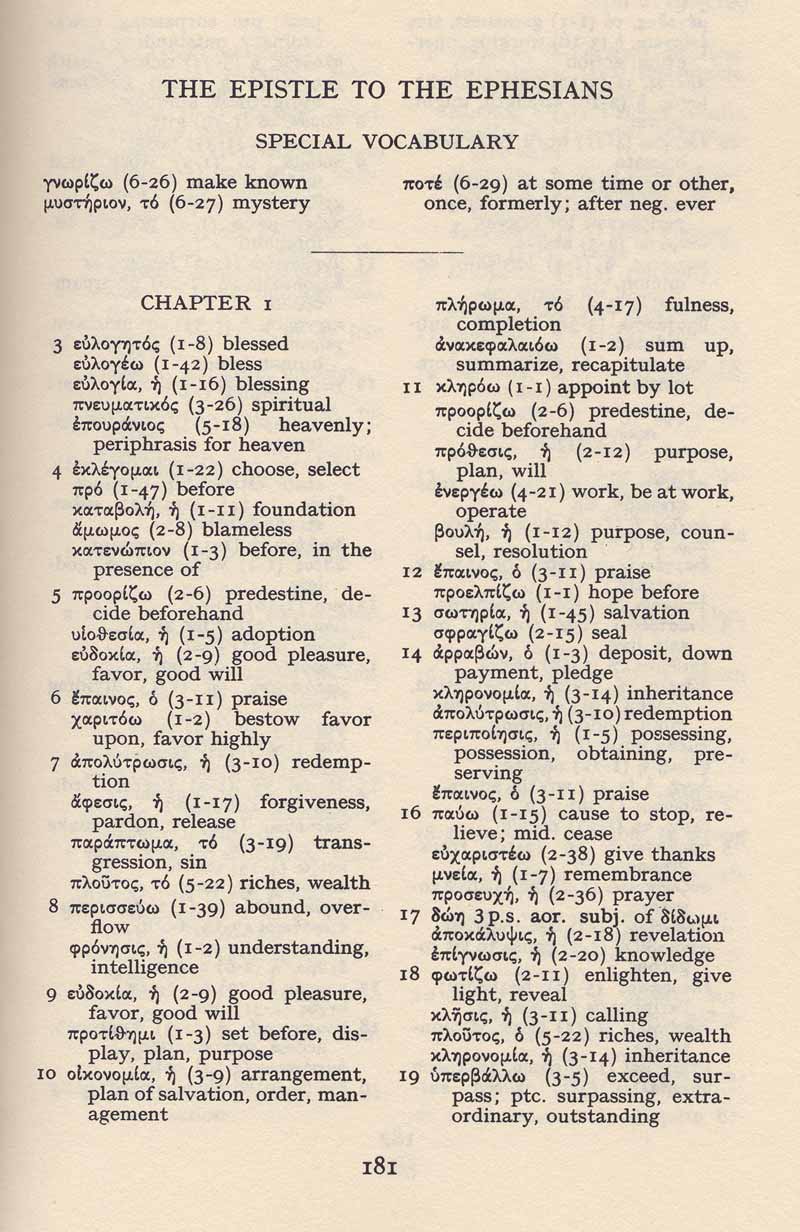
Even though having the vocabulary notes on the page are more convenient than in a separate book, this has been one of my all-time top Greek books.
The Reader’s Greek New Testament
Perschbacher’s volume didn’t make it, but A Reader’s Greek New Testament came in to fill the void.

This volume has vocabulary in footnotes for every work that occurs less than 30 times in the New Testament. It looks like all of the notes are vocabulary-related.
Koine Greek Reader - Decker
Decker’s Koine Greek Reader is a nice workbook-size Greek reader. It has selections from the New Testament, Septuagint, and some early Christian writers and creeds. This leads me to think that it is very poorly named, as it doesn’t have anything outside of Jewish/Christian religious literature but is called Koine. But it is good anyway.
It has vocabulary, morphological, syntax and some more general study notes. The data for his readings is kinda spread out, so I have to show you several screenshots for you to get a good idea of what it offers:


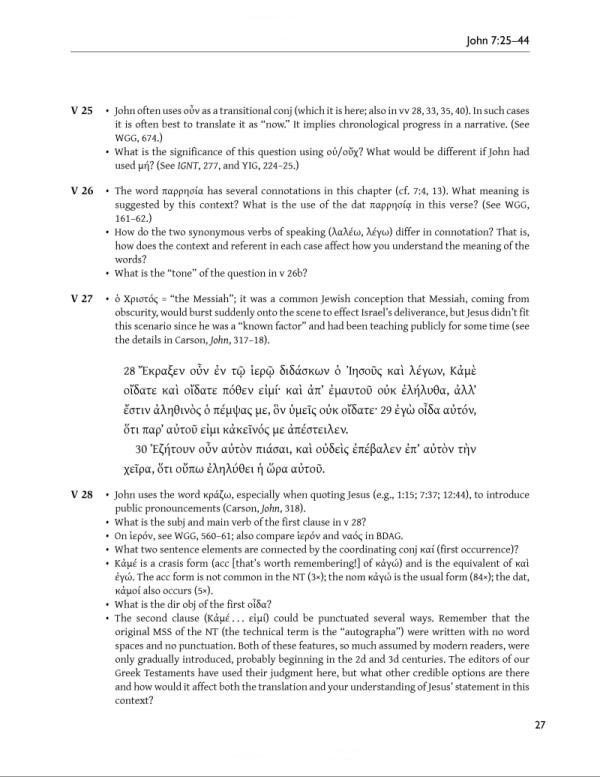

A Patristic Greek Reader - Whitacre
Another nice volume. A Patristic Greek Reader contains texts from a number of Christian fathers with vocab, morphological, and syntactical notes.
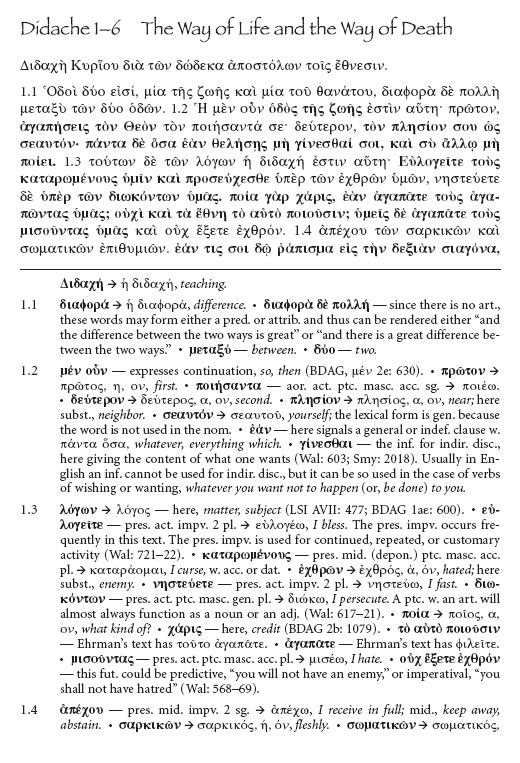

A Hellenistic Greek Reader - Colwell and Mantey
It has horrible typesetting though you should get it if you can because it is a useful volume. It was published in 1939 and is now out of print. It has selections from Christian and Jewish Greek, as well as selections from papyri and pagan Hellenistic Greek.
The vocabulary is not listed on the page (as you can see in the screenshot), but is included in a list in the back of the book.

A Beginner’s Reader / Grammar for NTG - Colwell and Tune
Published originally in 1965, A Beginner’s Reader-Grammar for New Testament Greek is now being reprinted by Hendrickson for fairly cheap. Apparently back in the day they were complaining about textbooks then as well, so Colwell and Tune decided to write a different grammar, so this is technically a beginning grammar, not a reader. They succeeded in being different. Is it an improvement? I’m not sure yet.
This volume starts with basic grammar and syntax before moving to a graded reader made up of adapted New Testament texts. Here’s a screenshot of the last page of the grammar and first of the reader:
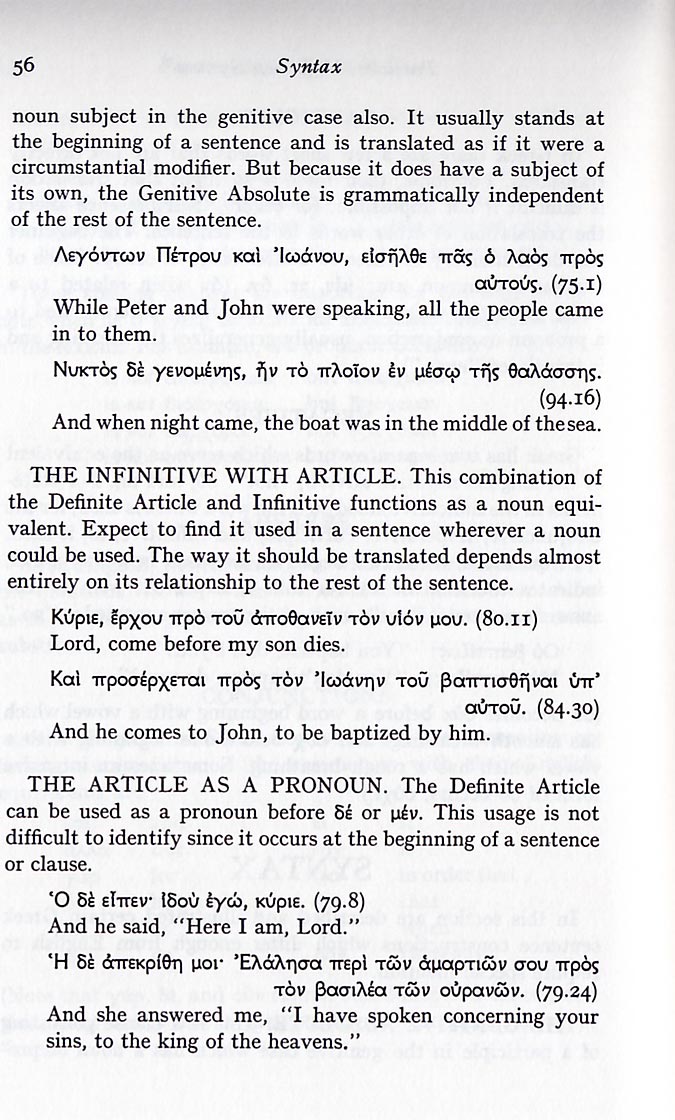

Graded Reader of Biblical Greek - Mounce
This Graded Reader of Biblical Greek is for those who have been through Mounce’s popular NT Greek textbook, though could be used after any first year NT Greek course. It is workbookish in size and contains 19 selections from biblical text and one from the Didache.

The reader includes both vocabulary and syntax notes. I’m not sure why the text is spaced out so much. I would go for less space and a smaller volume, but that’s just me...
Colson’s Greek Reader
This volume published in 1947 is out of print, and probably has been for a very long time. It’s subtitle is "Stories and Legends: A First Greek Reader". It comes with introductory remarks (about 17 pages of notes on syntax), texts, has exercises, and vocabulary lists (one for proper names and the other for other words) in the back. Below is a screenshot of the text followed by a one of the two vocabulary lists.
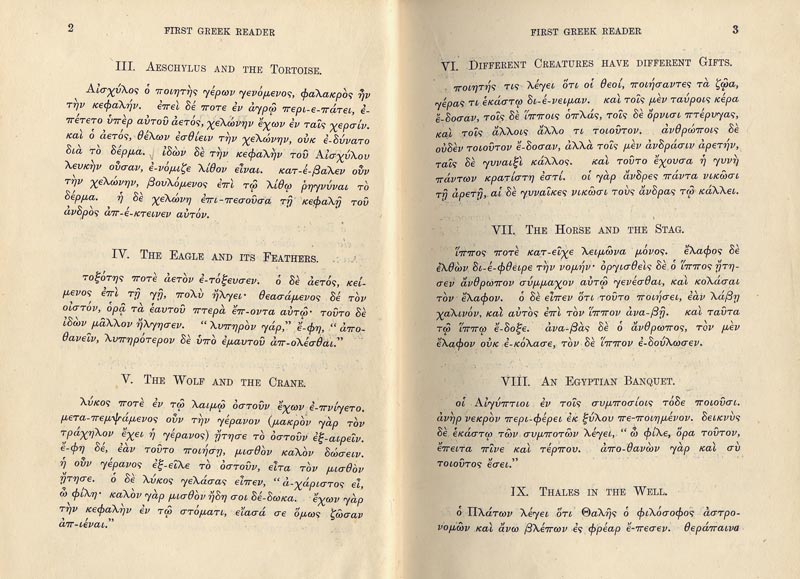

I don’t see anywhere where it says, but I would imagine that these are not selections directly from actual texts. My assumption is that the audience is classical.
JACT’s Reading Greek
The JACT’s Reading Greek textbook comes with a reader to work through as you go through the text. In the first edition the vocab was in the grammar volume, which I think was just a horrible idea. In the second edition it is included in the volume with the reader. Here are some screenshots:

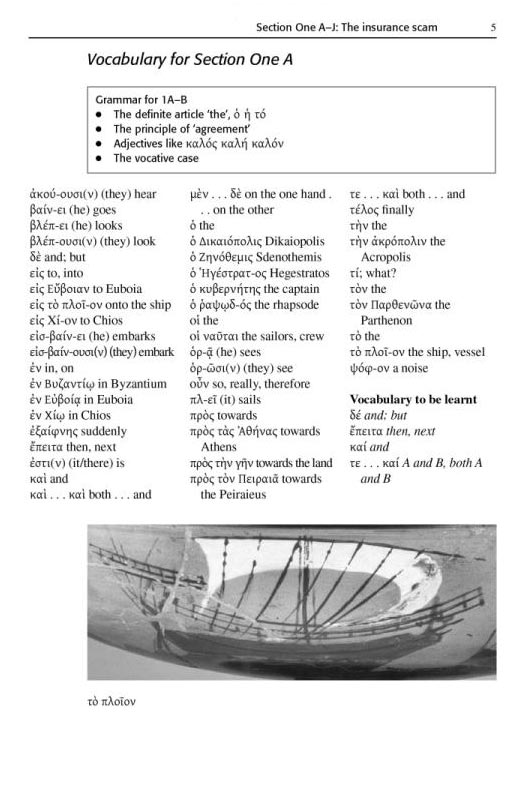
Along with vocabulary notes it has some nice pictures. From what reading I’ve done in it, it appears to frequently switch from narrative to dialogue. It adds a nice flavor.
JACT’s The Triumph of Odysseus
In what was an incredibly good idea, JACT decided to create a series of reader books that assume what you learn in their basic text. A great idea. This is the first one of those exhibited here (and there are several that I don’t have). The Triumph of Odysseus contains books 21 and 22 of the Odyssey.

Its notes are primarily vocabulary in focus, though it does branch out to historical background and story arch occasionally. Also, as you can see from the screenshot, readings are given context by a brief overview in English just before the reading (which is both good and bad, in my opinion).
JACT’s A Greek Anthology
This is another in the series of JACT readers. While the latter gave you a good long section from a single work to read through, this one, called A Greek Anthology, gives you smaller portions from multiple authors. Selections from the following are included in the volume:
- Homer
- Herodotus
- Aeschylus
- Sophocles
- Euripides
- Thucydides
- Aristophanes
- Plato
- Xenophon
- Demosthemes
- Aristotle
- Menander
- Plutarch
- The New Testament

JACT New Testament Greek: A Reader
Unlike most volumes in JACT’s Reading Greek series, their New Testament Greek: A Reader does not assume the vocab of JACT but rather the top 350 words by occurrence in the NT. If my calculations are correct, that means you would need to know every word that occurred 43 or more times in the NT.It also contains a short essay on the differences between Classical and New Testament Greek. The following are the selections contained in the work:
- Luke 1 and 2
- Mark 2-5
- Matthew 5-7
- John 9-11
- Luke 22-24
- Acts 1-2:21; 16-19
- Romans 4-6
- 1 Corinthians 12-15
- Hebrews 3-5:10
- James 1 and 2
- Revelation 21 and 22

Lucian: Selections Edited with Notes and Vocabulary - Keith Sidwell
This volume does not belong to the JACT series, but assumes the JACT vocabulary nonetheless with Lucian-specific vocabulary to be learned as well. First published in 1986, Lucian is still in print and you can get it from Amazon. The whole book looks like it was done with a typewriter so it can be hard on the eyes, but the content makes having it worth it for sure. The reader includes content from the following works:
- Dialogi Deorum
- Icarominippus
- Iuppiter Confutatus
- Dialogi Mortuorum
- Verae Historiae
- Somnium
- Demonax
- De Mercede conductis
- Quomodo Historia
- Philopseudeis

Some Latin Readers
These are not of direct relevance for Greek readers, but here are three more samples of readers from the world of Latin. I’ll be drawing on them in my follow-up post.
Aeneas to Augustus - by Hammond and Amory
Aeneas to Augustus: A Beginning Latin Reader for College Students is long for a reader being over 400 pages. It contains 90 selections from Latin works and contains notes primarily on vocabulary.


Columbus’ First Voyage - Iacona and George
Columbus’ First Voyage: Latin Selections from Peter Martyr’s De Orbo Novo is creative in terms of content, for sure. I am not used to seeing readers for this late of literature. It contains notes on vocabulary as well as pictures and little bits of historical data. This strikes me as perfect for a home-schooling family who is learning Latin. It is rather short (39 pages), but will make for interesting reading when I get around to learning Latin for real.


38 Latin Stories - Groton and May
38 Latin Stories contains short bits of Latin based on ancient authors and is meant to be used with Wheelock’s Latin textbook. Some are pure fabrications, some are adapted selections from actual Latin texts. The notes seem to be entirely vocabulary related.
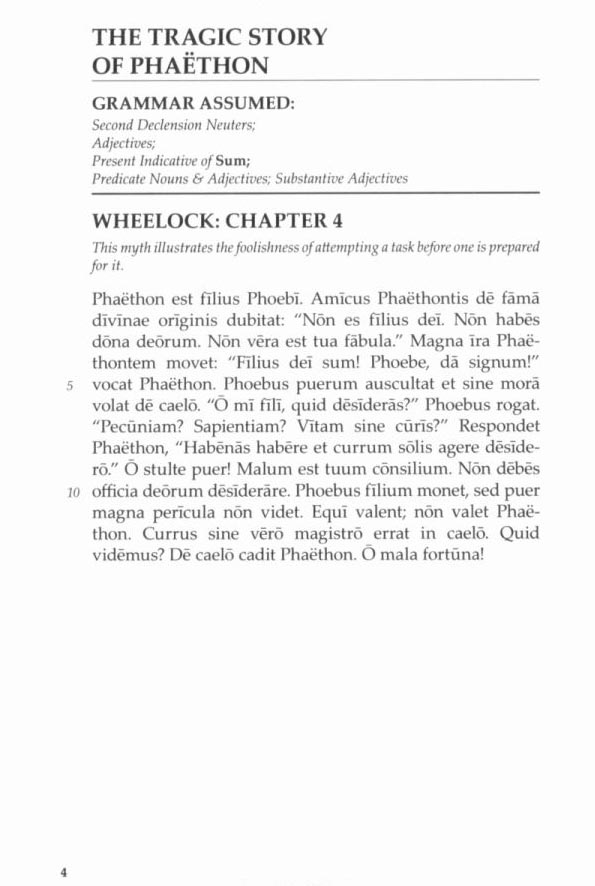

Conclusion
So there you go, a bunch of readers. Go out and read! It’s the best way to learn. Anybody have any readers that they think are noteworthy? If you’ve got a blog, post about it, let me know, and I’ll append a link. If not, leave a comment below!
Comments
Brett 2008-04-28 09:07:10
Oh great, there goes my food budget for the next few months. If you are going to post these kind of Blogs, you should send your readers (or, at least me) a few hundred dollars to offset their upcoming expenses.
BTW, what book does DTS use for first year Hebrew?
Oh well, off to Amazon I go.
Eric 2008-04-28 09:33:08
Sorry, man... For Hebrew, last I heard they used Pratico.
Nathan Stitt 2008-04-29 12:01:43
I was familiar with Mounce and JACT slightly. The Patristic Reader looks great, does it have all of the Apostolic Fathers or what? Couldn’t quite tell by the description.
Eric 2008-04-29 12:04:38
Yes it is nice, but no it does not cover all of the Apostolic Fathers. It contains selections from the Didache, 1 Clement, Ignatius, and the Epistle to Diognetus. All other selections are from later fathers.
Chuck Grantham 2008-04-29 12:53:51
Great roundup!
Now you’re sending me off to the book stacks to find my copy of _Grammar of Septuagint Greek_. Which I should have done before now, since it covers the Joseph story and would be good Greek exercise.
I’m pretty much sold on the UBS Reader’s GNT being the better of the newest pair, but Zondervan’s is smaller. The Koine and Patristic Readers do look interesting.
Ah for more money and more time!
Mike Bird 2008-04-29 02:45:23
I still have Kubo and a UBS4 beside my bed which I read through every night.
jeremy 2008-04-29 05:50:55
Great post! I’m familiar with several of these. As an alt. to Zondervan’s GNT Reader, there is also the UBS GNT Reader. Here is a review of it: http://homepage.mac.com/rmansfield/thislamp/files/20071210_ubsre_review.html.
For Latin readers there’s one more that may be of interest, as I’m sure there are plenty more: Wheelock’s Latin Reader, with selections from Cicero, Livy, Ovid, Pliny, and some Vulgate.
By the way, Zond is supposed be out (I think by now) with the Hebrew OT reader (yeah, I know this is focusing on Greek and Latin but I thought I’d throw that one in as well!).
Carl W. Conrad 2008-04-29 06:22:11
A very nice list! The more useful to your readers by virtue of the display of what each is like. You might want to repair the title of Aeneas to Augustus in a couple places: the name is Latinized from the Greek Αἰνείας and is one of those Greek 1st declension masculine nouns.
Eric 2008-04-29 07:29:39
Chuck: That grammar is a very nice book. I’ve spent a little time in it as well. Go forth and read!
Eric 2008-04-29 07:30:16
Mike: Thanks for dropping by. Kubo still holds a place in my heart. I used it for so many years...
Eric 2008-04-29 07:31:33
Jeremy: Yeah, I should have mentioned that UBS GNT Reader. I still use my NET/NA27 Diglot so I haven’t gotten around to buying either of the GNT readers. Some day... A Hebrew reader would be awesome. Would love to have that.
Eric 2008-04-29 07:33:57
Carl: Thanks. I didn’t know that about Αἰνείας. I do see I don’t even have the author’s spelling of the name consistent...will have to fix that!
Justin 2008-04-29 04:12:41
I have found "A Greek Prose Reading Course for Post-beginners" series by Malcolm Campbell to be excellent readers. The volume on Plato helped me appreciate and gain a sensitivity for Greek particles. The first book in the series on Lysias would be a good starting point for coming from Koine. The prices of the books are also reasonable which is a plus. There are 4 volumes in the series. Campbell covers Lysias, Plato, Demonsthenes, and Thucydides in each volume separately.
Eric 2008-04-29 06:29:29
I have a few books from the series (_Greek Vocabulary and Idiom_ as well as _Classical Greek Prose: A Basic Vocabulary_) but none of the readers except the Lucian volume. Do some of the others have better typesetting?
Seumas Macdonald 2008-04-30 04:04:03
thanks for a very good series. I’m quite fond of readers, they’re great for intermediate-type students to get some serious Greek reading done without being overly interrupted. I’m taking a group of seminary students through Whitacre at the moment. Plus, you pretty much summed up all my thoughts about Readers in your points, so double kudos to you.
Eric 2008-04-30 07:05:42
Thanks Seumas. I think taking some seminary students through Whitacre is a great idea. Let me know how they respond to it and how they learned from it.
Justin 2008-05-01 07:37:31
Hello Eric,
The typesetting of the Greek text is better than the word list in Greek Prose Vocabulary . I would suggest trying out the volume on Lysias and see how you like the series. I usually have another Greek text or print a copy of a text and work from the notes of the Greek Prose Reading book.
Eric 2008-05-01 07:46:01
Good advice. I need to start somewhere, so I'll start there.